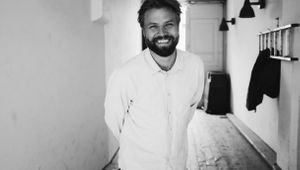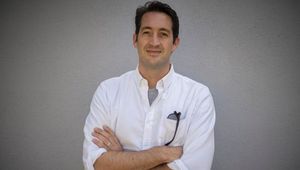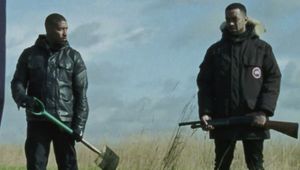
Your Shot: How This Interactive Slider Film Brilliantly Highlights The Need for Sustainability

Sustainability has long been an integral part of Swedish life. The Swedes began using renewable energy way back in the 1970s and two of its biggest exported brands, H&M and Ikea, are forerunners in the global quest for brand sustainability.
SPP is one of Sweden’s largest pension management companies and also one of the world’s most sustainable businesses. To showcase the importance of investing your pension money sustainably, agency M&C Saatchi Stockholm, digital production company B-Reel and director Patrik Gyllström decided to demonstrate the consequences of living unsustainably. The resulting film (in fact plural ‘films’) uses a slider technology that allows viewers to slide between two frames - a piece of tech made popular with still images on sites like Buzzfeed - and experience two parallel worlds simultaneously. It’s a very smart use of interactivity when applied to a film - make sure you check it out (only on desktop) here.
LBB’s Addison Capper chatted with M&C Saatchi creatives Linda Elers and Alexander Elers, and director Gyllström to find out how they made it happen.
LBB> Sustainability is a big topic amongst brands - but it does seem that many of them are more talk with little substance when it comes to actively working sustainably. How does SPP differ?
M&C> To SPP (and Storebrand, its mother company) sustainability is not only a nice word to use – it’s part of their foundation and who they are as a company.
SPP was one of the first companies to sign the UN-supported initiative Principles for Responsible Investments. They have been actively working with sustainability for so long (over 20 years), it’s really a part of the company's DNA. (Today SPP is ranked as one of the world's most sustainable companies, and has every year since 1999 qualified to DOW Jones Sustainability Index as in the top 10 per cent most sustainable brands globally in their category.)
Their sustainability work runs through the entire organization – from the food they serve in their company restaurant, to the monitor showing how much energy they have used in the building today, through travel policies, and - most importantly – the products they sell. All their funds are sustainable (from a social, economical and environmental point of view) and also classified through a ‘sustainability index’, which makes it clear and transparent for their customers to choose between them. As the biggest pensions provider in the Nordic region, SPP + Storebrand are investing tremendous amounts of money every year, so it naturally makes a huge difference that everything is invested sustainably.
LBB> Why is sustainability such a hot topic in Sweden?
M&C> Sustainability is today a hot topic in many countries, but it has been on top of the agenda in Sweden for a while now. The reason for that is, in short, that Sweden as a country ‘made it happen’. We invested in renewable energy well before most of the world caught on, starting already in the 1970s as a response to the oil crisis. We committed early to sustainability through recycling and other practices, as well as social and governance practices such as labour participation, education and institutional framework. Everything doesn’t come from the government though; H&M is a global leader in using organic cotton in garments, Ikea is a leader in solar energy. Swedes are a very conscious and switched on people, and entrepreneurs early discovered the financial benefits of sustainability and going green – which is the best news for the sustainability movement.
PG> That is a big question that I think would need an in-depth answer by an expert! But my short - and humble - opinion about it, is that I think Swedes have a socialistic history and heritage. That has given us a mindset that the people should be there for each other - it’s more about we, then I. And I think that mindset goes hand in hand with sustainability. Acting in a way that is not only good for you but more importantly, good for our fellow people.
LBB> Patrik, what was it about this job that made you want to get involved?
PG> I think many directors - me included - have thought once or twice about how fun it would be to get the chance to create a futuristic world. Where you get the opportunity to let your imagination run wild and create a world that doesn’t exit. And then adding the interactive dimension to the project really made it stand out and it felt like it could become really fun and challenging!
LBB> Why was Patrik the perfect match to helm the two films?
M&C> Patrik was extremely meticulous and wanted every detail to match as perfectly as possible. He also had both the artistic and the technical part of the film in mind – plus, he was easy to work with. Alex and I also have a tendency to be a bit perfectionistic and often have lots of opinions about things, so his way of working suited us very well. (Together we probably gave the producers a hard time, but they have been great throughout the whole production.)
LBB> Your aim was to show the future if people do not invest sustainably - what inspired you to use the ‘slider’ technology to drift between both films?
M&C> We remembered seeing before and after photos from the earthquake in Haiti in 2010 that used the same slider technology. The difference between the two versions was so dramatic, and pulling the slider was very engaging. We also wanted to show the two different versions of the future simultaneously. Using a slider felt new and like an exciting and interesting way of doing it.
PG> The visual approach of showing the two worlds by ‘sliding’ between them came from the agency. I think they wanted to find a way to really engage that audience, make them become physically a part of the experience by letting them make the choices as the film progressed.
LBB> I’ve seen the ‘slider’ technology used in images but never film. Were you worried about its feasibility at all?
M&C> Yes! We were really worried about technical problems and lag, since the whole experience is lost when it’s not completely seamless. To make it even more complicated, we also alter the sound effects and music as you slide.
To be honest, the result was even better than we had imagined. Phew!
LBB> How was it to get to grips with as a director? Logistically, how did you make it work?
PG> I haven´t seen it used in film either. But as you mention you have seen it in stills. That was one of the most interesting and challenging parts of the project - how can we make his concept work on moving images? And as you can imagine, it was a quite demanding task to mirror two films. But it just came down to doing it over and over until we had it. Basically we started with the bad version and shot it until we were happy, then we would re-dress the set to the good version. Use the take we like from the bad version, and then try to match the good version to it as good as we could. The most scary thing was that we had to decide on the spot which takes to use. So we did not have the luxury of picking and choosing takes in editing. We did use a motion controlled dolly for two of the scene, and used overlays to match takes between each other. But at end off the day it just came down to doing it over and over, and hope you get lucky.
LBB> Who did you work with on the digital development and build?
M&C> We worked with B-Reel for both the film production and the digital production, which was both necessary for finding leverage in the production and crucial for the result. They all worked with the end result in mind and were not only delivering ‘their part’ of the experience.
LBB> I really like the fact that the future film is a relatable view of the future - nothing too different from where we are now. Where did you draw inspiration from?
M&C> This was very important both for us and Patrik, the director. We had long discussions about what the future should look like. We all wanted to keep it realistic and avoid clichés (people in white clothes walking around in minimalistic buildings where everything is white and clean). We reminded ourselves that 30 years is not that long. We still have cars on our roads today from 1985 – not everything will be replaced in 2045. But still, we wanted to add some futuristic elements in every scene. We wanted to make technology incorporated in everyday items. Two of our references were the movies ‘Her’ and ‘Children of Men’.
PG> Me, Alexander and Linda had long discussions to find the right tone in the film. It was very important for us that it felt relatable, but also visually interesting. We also tried to fill it with stuff that was not too obvious. We really wanted the audience to discover new stuff the second or, if we were lucky, the third time they saw it. It terms of inspiration I think I looked at over 20-30 sci-fi movies in search for inspiration. The ones that stuck the most was Children of Men for the bad version and Her for the good version.
LBB> How tricky was it designing two mirror films like this? What added challenges did it throw up?
M&C> It was quite tricky. We wanted to add small details in both versions, so that you can see the film more than two times and still discover new things in it. We didn’t want all the action in the middle of the frame, but also on the sides so that it would be rewarding to move the slider constantly throughout the film. And we wanted people to have something to discover in every frame.
PG> Not having one of the fundamental tools in filmmaking at my disposal, editing!
LBB> What were the trickiest components and how did you overcome them?
M&C> The trickiest components were getting the actors to move similarly in both versions. (The absolute trickiest scene was the picnic in the park with all the children. They were tired, it was very sunny and hot that day and to get them to match was hard!) We shot the non-sustainable version first and chose which clip to use on set. (The client was great throughout the process.) Then we mirrored it with the non-sustainable version.
And one of the trickiest components was – as always – balancing time and money. Since we have two versions of every scene we actually had to make two films, not one. We shot everything in two-and-a-half days.
PG> Doing this very ambitious project on a tight budget. Unfortunately the only way to overcome that is to work really hard!
LBB> Any parting thoughts?
PG> I really want to give a shout out to the crew that worked on the project. They all did an amazing job. It was truly a collective effort that made it all come together.











